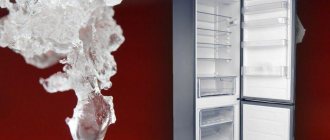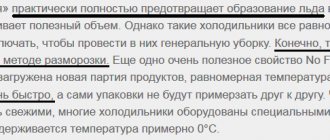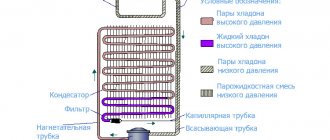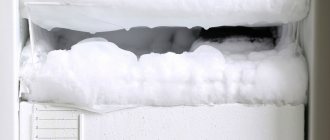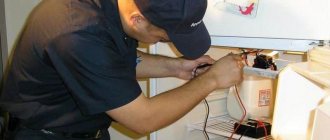Modern refrigerator manufacturers provide two main types of refrigerators in the market. There are many more refrigerators with drip defrosting function on the market than refrigerators with the No Frost system. Therefore, the choice of these household appliances of this format is quite diverse. Before purchasing a refrigerator, you should carefully study what drip defrosting is in order to understand all its advantages and disadvantages.
Refrigerator defrosting systems
The technology is not intended for compartments with temperatures below 0°C. To remove ice in domestic refrigeration units, 2 types of systems are used:
- Drip (or Nature Cool or Natur Cool), characterized by its simplicity of design. Since during operation of the system there is the formation of condensation flowing down the back wall, refrigerators are called “crying”. Condensation flows only along the rear surface of the refrigerator compartment, the side walls and door trim remain dry. The technology is not intended for compartments with temperatures below 0°C, so drip-type refrigerators require periodic defrosting.
- In 1973, the West German company Bosch introduced equipment equipped with the No Frost system. An electric heater is used to remove frost from the surface of the heat exchanger. The system includes a fan unit that evenly distributes the flow of cold air. The advantage of the technology is the ability to work at temperatures below 0°C (for example, in the freezer compartment). Due to automatic ice removal, periodic manual defrosting of the chambers is not required.
And there is also No Frost...
More expensive devices use a slightly different system, eliminating the possibility of freezing in the usual sense. These refrigerators have a compressor connected to a cooling panel. But cold air is distributed inside using coolers (fans), which ensure uniform flow. At the same time, a certain amount of condensate also collects on the surfaces, but it is much less than with drip technology.
How different types of defrosting work
How to defrost a Bosch, Atlant or Indesit refrigerator depends on the type of defrosting system that is installed in it. There are three main types:
- Manual;
- Automatic:
- Semi-automatic.
Manual. The principle of operation is as follows: the equipment is disconnected from the network, the food is taken out and they wait for the frozen ice to thaw. The water collects in the bottom tray, which then needs to be emptied. Therefore, owners of early models had to spend a long time defrosting.
Automatic. Installed in drip-type refrigerators, as well as No Frost models (LG, Bosch and others). How is it different from manual defrosting? In the first case, moisture collects on the walls of the chamber and forms a crust of ice and snow. In the second, drops of moisture collect on the inner wall and then flow into containers.
The drip system consists of:
- evaporator;
- compressor;
- containers.
The operating principle of the automatic type (or Direct Cool) is freezing-thawing. The consumer sets the desired temperature on the thermostat. The condensate freezes, and after reaching the desired temperature the unit turns off. Then defrosting occurs, and drops of moisture flow down the wall.
As soon as water accumulates in the pan, it is heated by the motor and turns into gas.
Do I need to defrost No Frost refrigerators? Their work is similar to drip, except that the cold air in the compartment is accelerated by a fan. Therefore, almost no condensation accumulates on the walls.
Semi-automatic. Refrigerators of this type perform defrosting on their own, but to do this, the user needs to start defrosting.
Maintenance
In some models of such refrigerators, an alarm is triggered when a large amount of ice appears. This means unplugging the refrigerator and letting the freezer thaw. But Automatic control is much more convenient.
However, one piece of technological wisdom should not be forgotten. One system is always more reliable than two systems working together. Otherwise, one alarm system will be more reliable than a sensor and a system for automatically turning off and turning on the compressor.
Some systems do not have a system for automatically evaporating the liquid formed when ice melts in the freezer. These systems require you to manually pull out the reservoirs and pour out the water.
This needs to be done for several reasons:
- Firstly, to avoid overfilling the tank and causing it to fail.
- Secondly, you don’t want a puddle on the kitchen floor, which, among other things, can lead to dampness and mold growth.
- Thirdly, this must be done before the water in the container spoils and emits a disgusting odor that will spread throughout the kitchen, and even in the freezer, lasting for a long time.
In addition to this, there are a number of other features. In addition to emptying the storage tank, you should periodically clean the ducts of the condensate drainage system. But be careful not to damage them.
You should also know that such refrigerators cannot be called quiet. They are often called crying refrigerators because of the characteristic sound of dripping water.
Principle of operation
After reading the operating instructions, equipment owners have a question about what a refrigerator defrosting drip system or NatureCool is. The drip principle is based on the condensation of water vapor on a surface at a low temperature. In refrigeration equipment, the minimum temperature is at the back wall of the chamber in contact with the heat exchanger body. Since a positive temperature is maintained in the refrigerator compartment, water vapor gradually settles on the back wall and then turns into ice.
To cool the wall, an evaporator radiator is used, into which the refrigerant compressed by the compressor is supplied. When a substance passes from a liquid to a gaseous state, heat is absorbed. The refrigerant gas then enters the compressor again and is compressed. The design of refrigeration units provides a regulator for the degree of cooling of internal cavities; on some models, a button is used to accelerate freezing (by increasing work productivity).
Peculiarities
The first models of “crying” refrigerators were equipped with tubular evaporators installed on the rear inner surface of the refrigerator. This solution significantly reduced the useful volume of the device and complicated the design of the drainage system for removing melt water. In modern models, the evaporator is integrated into the rear wall of the refrigerator and forms a single structure with it. With this design, the cooling element of the evaporator is the plastic surface of the chamber wall.
Moisture flows directly over its surface and is discharged into the tray through a drainage hole located at the bottom of the device.
Features of equipment with this thawing technology are:
- Ease of use.
- Reliability during operation.
- Low cost.
It should be taken into account that if the back wall is damaged by food, the surface of the “crying” evaporator may be “punctured”, which can lead to a violation of the tightness of the circuit. This defect is extremely difficult to eliminate due to the hidden location of the evaporator.
Why do you need to defrost your refrigerator?
When food is cooled in the refrigerator, condensation forms - moisture on the internal surfaces of the unit, which then freezes into ice build-ups. Condensation can occur for several reasons, but in a working refrigerator, the first most common factor is hot food. If you put, for example, a pot of hot soup in the refrigerator, the escaping steam will settle inside the refrigerator as a liquid. This happens due to the temperature difference between the products and the unit itself.
Of course, it is not recommended to put foods that are too hot in the refrigerator, and you can refrain from doing so. But with the freezer, things are different; ice build-ups can form in it even simply from the fact that food at room temperature is placed inside, which needs to be cooled and frozen. Ice also appears from the difference in temperature between the environment and the freezer when we open the chamber door.
If you follow the rules of use: do not put anything hot inside the refrigerator, do not keep the door open for a long time, etc., then ice will appear in small quantities, but you still need to get rid of it.
Firstly , ice build-up interferes with the proper operation of the refrigerator. Because of them, it is more difficult for the unit’s engine to maintain the required temperature inside, so the engine wears out.
Secondly , it interferes with washing internal surfaces. Because of the ice, it will not be possible to thoroughly wash all the walls, and it itself may contain food residues or frozen dirt.
Thirdly , the useful space of the chambers, especially the freezer, is wasted. Ice takes up the space in which you could put something.
These factors were especially pronounced in older generation refrigerators. Condensation formed in them in large quantities and quickly froze, so the units had to be defrosted more often. This was more difficult to do than in modern models: it was necessary to unplug the refrigerator, place a tray into which water would drain, and use a lot of rags, because... There was a lot of water after this procedure.
For ease of use, modern refrigerators are not only made more resistant to temperature changes, but many models are also equipped with a drip defrosting system, which helps optimize the process of caring for the unit.
Advantages and disadvantages of drip defrosting
Drip automatic defrosting system in a modern refrigerator: what does this technology give to the consumer? First of all, such a system is harmless to human health and does not affect the quality of products. In addition, drip defrosting gives the owner a lot of advantages over the manual defrosting method:
- The refrigerator compartment defrosts automatically, which saves a lot of time.
- During the defrosting process, the use of additional devices is not required: hair dryer, scrapers, etc.
- The device maintains an optimal level of humidity, allowing you to keep fruits and vegetables fresh for a long period of time.
The disadvantages of the drip defrosting system for the refrigeration chamber can be considered:
- The difference in surface temperature of the rear wall of the refrigerator compartment, which in the lower and upper parts can reach 5°C.
- Stopping the refrigerator can negatively affect the quality of perishable food products.
- A clogged drainage system leads to water appearing at the bottom of the device.
- The effect of the “crying” evaporator applies only to the refrigerator compartment, without affecting the freezer.
So, drip automatic defrosting system, is it good or bad? According to the general opinion of service center specialists, the main advantage of this technology is the simplicity of the design, which affects the cost of the device. The main disadvantage is the possible peeling of the back wall of the refrigerator from the surface of the evaporator. The air gap disrupts the thermoregulation process in the chamber, the compressor stops turning off, which leads to icing of the back wall of the refrigerator.
What to choose, drip defrosting or an air defrosting device - this must be decided by the consumer, based on his financial capabilities and requirements for the refrigeration cabinet.
No Frost: myths and reality
In addition to the listed advantages and disadvantages, there are also some prejudices associated with the dry cooling system. Let's discuss some of them and find out how the situation really is.
Unpleasant odors and rapid drying of food
Some housewives believe that due to the air circulation provided by fans, food can “weather” and dry out a little, and unpleasant odors from fish or onions spread faster throughout the chamber. This is quite controversial.
- Leaving food uncovered, even in the refrigerator, is simply not hygienic.
- If you place strong-smelling foods in a bag or special container, no odors will be harmful.
- Almost all vegetables and fruits are stored much better if there is airflow, because increased humidity leads to a natural process of rotting.
No Frost does not require defrosting at all
This statement is still not true. Of course, No Frost needs to be defrosted so rarely that it’s not worth talking about. But it is still necessary to do this, at least for reasons of hygiene. It is almost impossible to thoroughly wash and disinfect a working unit.
“Dry” refrigerator is dangerous to health
This myth is based on the fact that some special, especially dangerous refrigerant is used to operate refrigerators of this type. This is wrong. Both the compressors and the refrigerant for their operation are the same in both types of refrigerators. The only difference is in the use of blowing with the same air that we breathe every day.
In addition, the features of any cooling system are such that the refrigerant is located in a hermetically sealed system and does not affect the environment at all.
There are no No Frosts with large chambers
Of course, fans take up some space, but it’s not that critical. In the end, when choosing a model, you can simply buy a taller or wider refrigerator, focusing specifically on the internal volume of the chamber.
Refrigerators of this system are very noisy
On the one hand, this is true. But if you are not too strapped for money, give preference to newer and more expensive models that are equipped with excellent sound insulation. Such a refrigerator will work even quieter than a drip refrigerator.
"But frost" consumes more electricity
But this, in general, is not a myth. “Anti-freeze” devices actually draw more electricity. However, this difference is so insignificant that it most likely will not make a big hole in your budget. This is especially true for current year models.
Comparison with No Frost
Products supporting No Frost technology are characterized by a reduced level of humidity inside the chambers, which reduces the likelihood of frost appearing on surfaces. To ensure the circulation of air flows, fans are used, which additionally prevent the appearance of ice. The evaporation unit is located in the partition between the freezer compartment and the refrigerator compartment. Since a small amount of frost forms on the walls, manufacturers recommend manual cleaning of the units at least once a year.
The equipment is equipped with a partial or full No Frost system, which differs in the number of chambers included in the unit. The partial system supports the operation of only the freezer compartment; a drip unit is mounted in the refrigerator compartment. Some refrigeration units use Neo Frost technology, which is characterized by the use of separate fan units in the freezer and refrigerator compartment. The use of separate circuits allows you to separately regulate humidity and prevent the passage of unpleasant odors between compartments.
Advantages of the equipment (compared to drip defrosting of the refrigerator):
- does not require constant care;
- accelerated cooling of chambers after turning on the power;
- increasing the shelf life of fruits (due to a drop in humidity levels);
- support for accelerated freezing function (with automatic electronic control).
Alternative defrosting technologies
In recent years, technologies with declared full automation in terms of defrost adjustment have proven themselves well. They free the freezer and refrigerator compartments from frost formation without human intervention.
No Frost
The term “No Frost” is literally translated as “without frost.” No Frost is a cooling system for freezer and refrigerator compartments that provides forced circulation of cold air and prevents the formation of ice. This type of unit ensures uniform distribution of air, so there are no zones with sudden temperature changes that lead to condensation and freezing of moisture.
Such units are not only capable of self-defrosting, but also provide dry freezing of products. Such devices cool or freeze food quickly and evenly. This allows you to preserve their appearance, taste and beneficial properties (vitamins, minerals). All types of berries, herbs, fish and meat, and most vegetables are suitable for dry freezing.
Important! Moisture in No Frost refrigerators does not freeze on the walls, as in a drip system, but collects on the evaporator.
Naturecool
The German brand Bosh has developed a new technology called Naturecool. This is a type of cooling in refrigerators that does not use forced air circulation. The cold spreads throughout the chamber directly from the evaporator, which is located inside the walls of the unit.
The inside of the freezer is not equipped with metal parts. Ice does not form in the chambers, since there is no contact between warm and humidified air. Such refrigerators are able to preserve the natural freshness, taste and aroma of food for a long time.
Refrigerator design with a drip system
Refrigerators with drip defrosting element by element include:
- compressor;
- a condenser (zigzag tube on the back wall) filled with refrigerant - heat is removed through it to the outside;
- capillary tube (in which gaseous refrigerant condenses into liquid);
- the evaporator (tubes inside) absorbs heat from the internal chambers, cooling them;
- a relay with which you can control the temperature.
For greater efficiency of cooling processes, the inside of the refrigerator body is lined with heat-insulating materials. The internal volume of the refrigerator does not reveal the presence of technical elements and meters of all kinds of tubes; the walls are smooth.
On a note! New models of refrigerators are equipped with displays that display information about the temperature inside. Here the accuracy of the set mode is +/- 0.5 degrees.
How to defrost a refrigerator with this system
To defrost a drip refrigerator, you will need to follow these steps:
- Open the doors and remove the food inside. If a large amount of ice has formed in the freezer compartment and food has frozen into it, it is recommended to wait 20-30 minutes for the frost to soften. If the procedure does not help, then the products are removed from the chamber as the container is freed from the ice crust.
- Turn off the power supply to the equipment and place moisture-absorbing materials under the housing. To speed up the defrosting process, the front doors remain open. Some products use a special extension tube to drain water from the drainage hole into a previously prepared container.
- Wait until any remaining ice and moisture is removed, and then wipe the interior of the refrigeration unit with a clean, dry cloth. If an unpleasant odor is detected, it is recommended to wash the parts with a baking soda solution. Additionally, any remaining dirt that has accumulated under the rubber sealing frames on the doors should be removed.
Drip defrosting of a refrigerator takes several hours. It is strictly forbidden to speed up the procedure by chipping the ice with plastic, wooden or metal elements. If handled carelessly, there is a risk of breakdown or breakage of the refrigerant circulation tubes. The gas is colorless and odorless, so the leak will only be detected when the equipment is put back into operation. If a leak is detected, further use of the refrigerator is prohibited and you must contact a service center.
Tips for choosing
Well, a few more tips for those who are going to choose a refrigerator. In order not to make a mistake with your choice, you need to look at the situation a little more broadly. It is not enough to simply decide on the type of refrigerator. You also need to pay close attention to other parameters:
- the cost of a specific model;
- the maximum dimensions of the unit that your kitchen can accommodate;
- energy saving level;
- the presence of a “dry freezing” system, if needed;
- internal equipment, the presence of a sufficient number of shelves, drawers and compartments;
- design solution;
- presence of a door re-hanging system;
- the ability to quickly and easily obtain warranty service, the availability of service centers.
Rating of refrigerators with drip defrosting
We will present the best models, according to customer reviews.
INDESIT ST 145
A popular two-chamber model, budget-friendly thanks to the “crying evaporator”. The control is as simple as possible, electromechanical. Energy class B, consumes 405 kW per year. The freezer is defrosted manually.
The total volume is 249 liters. Keeps cool for 14 hours after a power outage. The noise level reaches 42 dB. Case dimensions: 60x67x145 cm.
Price - from 13,000 rubles.
POZIS RK-102
Refrigerator with two chambers. The freezer is located at the bottom, defrosting is manual. The refrigerator compartment is equipped with a drip system. It consumes energy economically - 226.3 kW per year, belongs to class A+. Capable of freezing up to 4 kg per day.
RK-102 maintains temperature offline for 13 hours. The total volume of the compartments is 285 liters. LED lighting in the chamber allows you to save electricity. Noise level during operation - 40 dB.
Case dimensions: 60x63x162 cm.
Cost - from 14,000 rubles.
ATLANT XM 4026-000
Oversized model with an exquisite design - 60 x 205 x 63 cm. Single-compressor refrigerator with drip defrosting system. Useful volume - 393 l, freezer - 115 l, refrigerator compartment - 278 l.
reversible door;
quite high freezing power;
shelves and containers for vegetables are made of high-quality durable plastic;
quiet in operation;
Manufacturer's warranty - 3 years.
Bosch KGV39XW22R
Equipment from a high-quality equipment manufacturer. Model dimensions - 60 x 200 x 63 cm. total usable volume - 351 l, freezer - 94 l, refrigerator - 257 l. Single-compressor refrigerator with private defrosting system.
the door can be reversed;
low amount of electricity consumed;
quiet in operation;
presence of a freshness zone;
ergonomic placement of shelves.
Indesit DS 4200 W
Single-compressor unit with a laconic, stylish design. Dimensions - 60 x 200 x 64 cm. Total volume - 339 l, freezer compartment - 87 l, refrigerator compartment - 231 l.
energy consumption class A+;
almost silent in operation;
easy to manage.
Pozis RK-149 S
Large refrigerator with dimensions 60 x 196 x 65 cm. Useful volume - 370 l, of which the refrigerator compartment is 240 l, the freezer compartment is 130 l. The model has high food freezing power.
low energy consumption;
reversible door;
works quietly;
interesting design;
capacity.
Prices in online stores
Review of the best models
With a wide range of refrigeration equipment available in the household market, buyers give preference to certain models. Here is a brief overview of the most popular products for home use of each defrosting system.
Refrigerators with drip system
All presented devices are highly rated by consumers, which confirms their widespread use at home.
BEKO RDSK 240M00 W
This model is famous for its ease and ease of use, as well as economical energy consumption. Durable shelves made of shockproof glass can withstand significant loads. There is a possibility of reversing the door, which allows you to place the refrigerator in any convenient place. Customers like the device for its quiet operation, convenient dimensions, and spacious volume.
The BEKO RDSK 240M00 W model is praised for its quiet operation and low power consumption
NORD NRT 144–032
According to customer reviews, this model operates quite quietly and consumes a small amount of electricity. However, many buyers were not satisfied with the small volume of the freezer. For large families, such a refrigerator will still be too small, although the refrigerator compartment boasts spaciousness. The refrigerator is easy to use, is not equipped with additional functions, and quickly reaches the desired temperature.
Buyers of the NORD NRT 144–032 model complain about the insufficient capacity of the freezer compartment
ATLANT ХМ 4010–022
Buyers praise this model for its spacious freezer and note the silent operation of the compressor. One of the minuses identified is the small space of the refrigeration compartment. However, frozen food lovers appreciated it.
The ATLANT XM 4010–022 model is famous for its spacious freezer and small-volume refrigerator compartment
"Biryusa M149"
Customer reviews speak of the model’s spaciousness, low noise, bright LED lighting and stylish appearance that can fit into any interior. There is a sound indication that signals when the door is open. In addition, there is a slight accumulation of condensation on the rear wall. Negative characteristics include the lack of a tray for freezing ice and the small size of the egg tray.
The Biryusa M149 model features bright LED lighting and sound indication of an open door
Sharp SJ-B132ZRWH
A special feature of the model is the complete shutdown of the refrigerator when the door is open for a long time. Buyers note this feature as a disadvantage. In addition, the instructions do not contain information about this possibility.
A thin layer of frost freezes on the back wall; the more the refrigerator is loaded, the larger the layer becomes. As for noise, users note increased noise at the time of initial startup, however, after a certain time, the noise subsides and the compressor continues to operate almost inaudibly.
Unlike its counterparts, the refrigerator is equipped with wheels, which makes it much easier to move. In addition, housewives note that the size of the box for eggs is too small - 7 pieces, and those who like to store plastic bottles in doors - the capacity of a two-liter bottle on a shelf in the door. Nevertheless, this model has high customer ratings, characterizing it as an ideal price-quality ratio.
The Sharp SJ-B132ZRWH model has wheels for easy movement of the refrigerator
Table: comparative characteristics of drip models
| Characteristic | Model | ||||
| BEKO RDSK 240M00 W | NORD NRT 144–032 | ATLANT ХМ 4010–022 | "Biryusa M149" | Sharp SJ-B132ZRWH | |
| Freezer location | above | above | from below | from below | from below |
| Color/Coating Material | white/plastic/metal | white/plastic/metal | white/plastic/metal | silver/plastic | white/plastic/metal |
| Control | electromechanical | electromechanical | electromechanical | electromechanical | electronic |
| Energy consumption | class A (284 kW/year) | class A+ (303 kWh/year) | class A (325 kWh/year) | class A (310 kWh/year) | class A+ |
| Number of compressors | 1 | 1 | 1 | 1 | 1 |
| Refrigerant | R600a (isobutane) | R600a (isobutane) | R600a (isobutane) | R600a (isobutane) | R600a (isobutane) |
| Number of cameras | 2 | 2 | 2 | 2 | 2 |
| Dimensions (WxDxH), cm | 54x60x145.8 | 57x62x178 | 60x63x161 | 60×62,5×207 | 60x65x185 |
| Defrosting the freezer | manual | manual | manual | manual | manual |
| Defrosting the refrigerator compartment | drip system | drip system | drip system | drip system | drip system |
| Autonomous cold storage | until 16:00 | TBC | until 17:00 | until 17:00 | TBC |
| Freezing power | up to 4 kg/day | TBC | up to 4.5 kg/day | up to 5 kg/day | TBC |
| Total volume, l | 223 | 330 | 283 | 380 | 317 |
| Refrigerator chamber volume, l | 177 | 262 | 168 | 245 | 223 |
| Freezer volume, l | 46 | 68 | 115 | 135 | 94 |
| Ice maker | absent | absent | absent | absent | absent |
| Noise level | up to 40 dB | up to 39 dB | up to 39 dB | up to 41 dB | TBC |
| Weight, kg | 42,6 | 56 | 56 | 81 | TBC |
| Minimum freezer temperature | — 24 °C | -18 °C | -18 °C | -18 °C | — 24 °C |
| Shelf material | glass | glass | glass | glass | glass |
| Possibility of reversing the door | There is | There is | There is | There is | There is |
| Climate class | N, SN | TBC | N | TBC | SN, T |
| Antibacterial coating | There is | There is | No | No | There is |
| Additional features | open door indication | temperature display | |||
Caring for your drip refrigerator
Its service life depends on timely and proper maintenance of the refrigeration cabinet. To prolong it as much as possible, experts recommend:
- Completely defrost the chambers of the refrigeration unit.
- Wash the interior and all structural elements (including compartments for vegetables, shelves, trays for storing eggs). Carry out washing at least once every 6 months. For this process, you should use a special refrigerator cleaner or a solution of water and dishwashing detergent.
- Wipe all surfaces dry.
- Remove dust from the evaporator located on the outside of the rear wall of the refrigerator. This procedure is recommended to be carried out at least once every two months.
Important! The use of abrasive and aggressive detergents should be avoided. Particular attention should be paid to the rear panel of the device. You should not remove ice from its surface mechanically: with scrapers, brushes and other objects that could damage the integrity of the evaporator.
Often, housewives are faced with the problem of the appearance of unpleasant odors in the drip refrigerator. The main reason is mold, which appears due to accumulated moisture in a faulty drainage system or meltwater collection pan.
To get rid of the unpleasant odor, you need to clean the drainage hole, then thoroughly wash the device with a special product or an aqueous solution of ammonia in the proportion: per 1 liter of water 1 tbsp. spoon of ammonia. You can also use more modern means: a UV lamp, an air ionizer or an odor absorber for refrigerators, which can be filled with carbon or silica gel.



